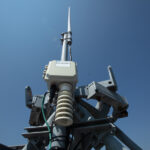Through recent test results, Satellite Time and Location (STL) from Satelles, a globally available alternative PNT service from low Earth orbit (LEO), has again proven to be a reliable timing source.
In 2021, Satelles was awarded a contract by the European Commission’s Directorate-General for Defence Industry and Space (DEFIS) to participate in a study of alternative PNT (A-PNT), and was the only U.S. firm to do so, according to a news release. Based on results from the broad evaluation of positioning, navigation and timing (PNT) technologies, which included onsite tests at the European Commission’s Joint Research Centre (JRC) and VIP demonstrations, STL exceeded expectations for complementary technology to GNSS in Europe.
As stated by the EC, the aim of the project was to “analyze the technologies which could deliver positioning and/or timing information independently from GNSS, to be effective backup in the event of GNSS disruption, and if possible, to be able to provide PNT in the environments where GNSS cannot be delivered.”
A demonstration day for all test participants was held in May 2022, with EC government officials and other dignitaries with backgrounds in PNT, metrology and critical infrastructure in attendance. The results were published in the JRC’s final report, released last week.
Since the demonstrations, Satelles has continued to optimize STL technology, achieving results as low as 26 nanoseconds at 1 sigma.
Test results
For the outdoor static timing test, the JRC studied STL while operating in the absence of a signal from GNSS for progressively longer periods of 1, 14 and 100 days. Using a traditional exterior roof-mounted antenna, STL achieved accuracy relative to Coordinated Universal Time (UTC) across all test intervals with 100% availability and timing stability. For the 100-day test, STL produced a frequency stability (Allan deviation) of 2.28E-13 while operating with 100% availability for the duration of the test.
For indoor static timing, JRC testing included two scenarios with a small indoor antenna located in the center of the ground floor of a large building at the JRC facility. In both placements (with the antenna on top of a filing cabinet and inside the filing cabinet for a separate trial), STL achieved 100% availability and accuracy relative to UTC. During the demonstration day, STL provided reliable service even when the indoor antenna and receiver were placed in a JRC bunker with concrete walls one meter thick and sealed by a heavy steel door.
JRC engineers evaluated STL’s positioning capabilities using the same outdoor and indoor fixed antenna configurations as the timing tests to test static positioning. Operating for 100 days, surpassing the EC’s 7-day and 24-hour periods for outdoor and indoor testing, and with 100% availability, STL delivered horizontal positioning accuracy (95%) of 26.6 meters and vertical positioning accuracy (95%) of 16.8 meters. These values were significantly better than the EC’s requirement, which called for PNT technologies to be accurate to within 100 meters at the 95th percentile.
STL receivers also demonstrated true plug-and-play operation, with on-site calibration neither required nor applied before any testing, including the 100-day test. It took less than 10 minutes to set up the equipment and less than one minute to output an accurate position and time with an indoor antenna.
A dependable timing source
The EC’s assessment follows an announcement in March 2022 about two key reports from the U.S. National Institute of Standards and Technology (NIST) that highlight the suitability of STL as a source of resilient time for applications such as 5G wireless networks and electrical grids. The U.S. Department of Transportation also described the exemplary performance of STL in its 2021 report on complementary PNT and GPS backup technologies.
“Our enterprise customers have known for years that STL is a solution they can depend on as a primary source of timing for applications with performance or operational requirements not met by GPS/GNSS, such as 5G wireless network deployments where other timing solutions do not operate indoors or cannot provide the required level of accuracy. These and other users also need STL as a backup to protect GPS/GNSS dependent systems and platforms from the impacts of a service disruption,” Satelles Vice President and General Manager, Commercial Enterprise Solutions Christina Riley said. “The incredible performance of STL in the absence of GNSS signals during the EC study confirms that STL is a reliable timing source rather than merely a time transfer method.”






